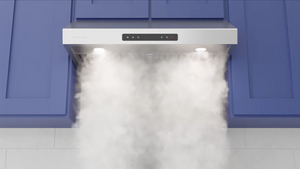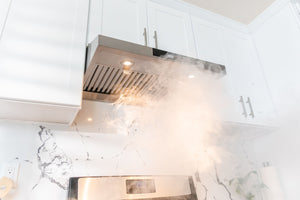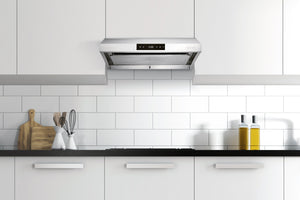TIPS & GUIDES
What Does a Bathroom Exhaust Fan Do and Do You Need One?
By Hauslane ∙ 5 mins readThink about your typical home bathroom. It should include a sink, vanity, lighting fixtures, faucet, mirror, toilet, shower, and exhaust fan. The exhaust fan is often seen as a “nice-to-have” when it comes to bathrooms. However, in reality, that couldn’t be further from the truth.
To keep your bathroom clean and hygienic, an exhaust fan is an absolute must. Here’s what you need to know about how the fans work, their benefits, and how to select the right one for your home.

How Does a Bathroom Exhaust Fan Work?
Bathroom exhaust fans are wired to the household’s electrical current, similar to a light fixture. When you turn on the wall switch, it operates the fan and may turn on a timer to shut off the fan after a certain amount of time. The bathroom exhaust fan then moves the interior air out of the bathroom through a vent duct or flexible tube to the exterior. This vent duct then transports the air through the roof or an exit vent on the building’s sidewall. The duct is kept closed when not in use through a cover plate on the vent’s exit.
Many building codes require bathroom exhaust fans for new construction or remodeling projects. In the state of California, all bathrooms must be equipped with fans that have humidity and motion sensors under Title 24. These fans activate when the humidity level meets a predetermined threshold or the sensor notes motion (BF200HM-5000K). These features are required to pass inspection and meet building codes.
Generally, the size of the fan should match the square footage of the bathroom to provide the proper amount of ventilation. Even if a bathroom exhaust fan is not required for building codes, they are recommended to improve your home’s air quality.
The Benefits of Having a Bathroom Exhaust Fan
Why do bathroom vents matter? Can’t you just open a window or leave the bathroom door open after a shower? Not quite. Without an exhaust fan, you can expect to have mold growing in your shower, peeling paint, and even damaged drywall. Prolonged moisture buildup is a disaster for the bathroom; picture damaged walls, floors, ceilings, fixtures, and even doors. That’s something no homeowner wants to face!
Excessive moisture is bad news for any part of your house, but the bathroom is especially susceptible to dampness. The last thing you want is mold and mildew all over your walls and shower. Mold spores travel by air. So, while you may first notice mold growing on your shower wall, you can expect it to travel parts of your home.
Mold is not only unattractive but also dangerous. According to the CDC, mold can cause congestion, wheezing, itchy eyes, red skin, and other upper respiratory issues. It is particularly hazardous to people with asthma or allergies to mold. Breathing in these spores can cause headaches and nausea as well. Once mold enters your bathroom, it’s incredibly hard to get rid of and may even require professional removal or remediation services.
Exhaust fans draw out the moisture caused by baths, shows, and daily bathroom use. They pull out the warm air, so no lingering moisture has time to grow spores and damage the bathroom. They also help to remove any odors from the room. If you’ve ever used a bathroom without a working exhaust fan, you probably noticed the space feels warm and smells musty.
For the most hygienic and safe bathroom, install a quality exhaust fan and use it on a regular basis..
What to Look For in Your Bathroom Exhaust Fan
There are many different types of bathroom exhaust fans on the market. You’ll find a range of styles and features to suit your needs and your home’s aesthetic. Some bathroom exhaust fans come equipped with sensors that switch on the fan when they detect humidity in the bathrooms. Others have timers and automatic shutoffs. You can also find fans with light fixtures, heat lamps, Bluetooth, and speakers.
The individual features you choose will depend on your needs; however, we recommend prioritizing performance, durability, and safety. All the bells and whistles in the world don’t matter if your exhaust fan doesn’t work!
Performance
First, make sure the exhaust fan has the appropriate operating capacity for the square footage of your bathroom. You can’t rely on the size of the exhaust fan to determine its capacity. Instead, review the manufacturer’s recommendations regarding square footage coverage.
You can go too far with vent fan capacity. If you select a model with excessive capacity for your bathroom, it can create negative pressure in the space. It can affect the air circulation in your home and furnace ducts. When in doubt, double-check the product’s recommendations for capacity and square footage.
Sound also matters. If the bathroom fan is too noisy, you may be hesitant to use it. Loud fans can be bothersome and annoying, especially in a household with multiple occupants. Who wants to listen to a fan rattle while you’re taking a relaxing bubble bath?
Look for fans that operate with minimal noise. You can check out product reviews to see what the daily operating experience of the fan is like.
Durability
Your bathroom exhaust fan should be built to last! When it comes to home maintenance, few of us want to fool with appliances on a regular basis. A functional fan will protect your home against mold and moisture and your family’s health for the long-term.
Durable bathroom exhaust fans will be made of quality materials and backed by a warranty. Be sure to review the installation requirements to verify the model will work with your space.
Safety
How important is safety for bathroom exhaust fans? In a word: very. Remember: the fan is connected to your electrical system. It also operates in a room that has a lot of water and moisture. Don’t skimp out when it comes to safety!
How do you determine if a model is safe? Look for models that have an ETL or UL certification. Products with these certifications have met rigorous safety and operating standards.
Once you find the right bathroom exhaust fan, don’t forget to run it after using the shower or bath. Doing so will help you keep your bathroom free of excess moisture and smelling fresh.
For more tips on getting the most out of your house’s appliances, stay tuned to the Hauslane blog.




















































